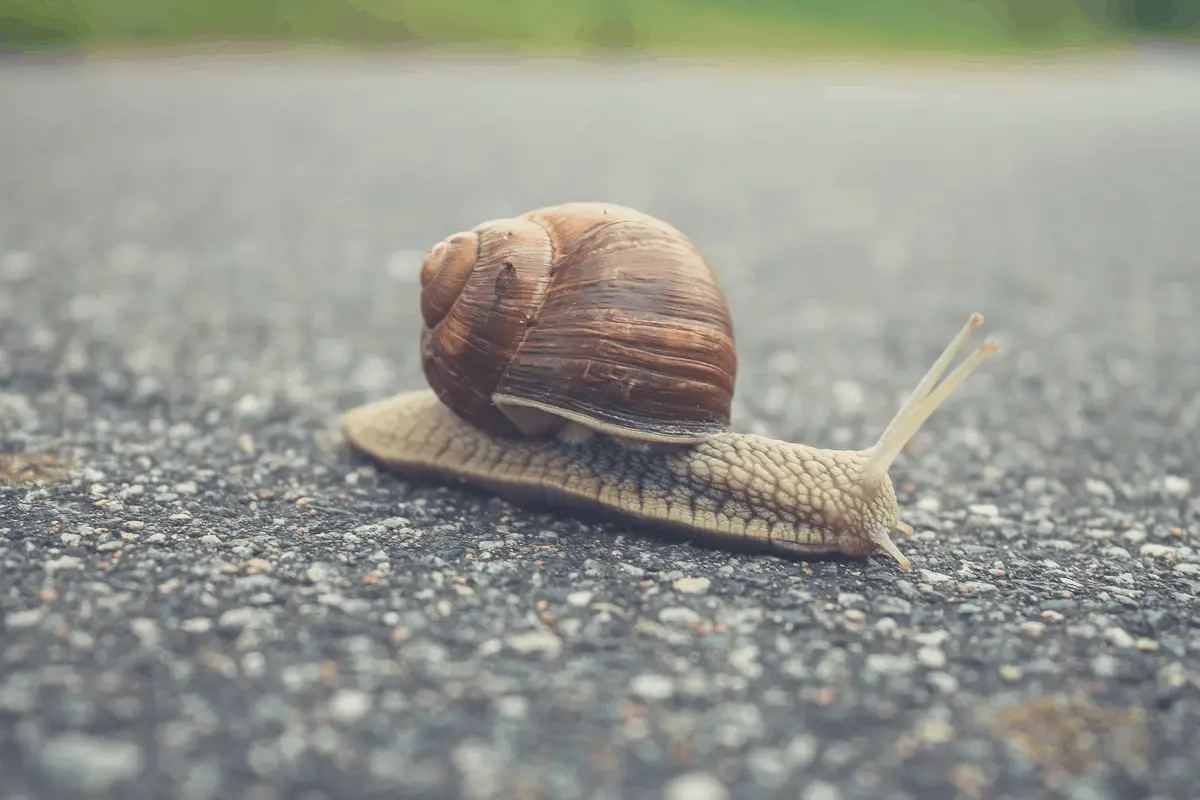Have you always been fascinated by the idea of raising snails? If yes, getting one of these gastropods finally can be an exciting period in life. With each passing day, you can learn more about these pets in terms of what they eat, how they move, and their sleeping patterns.
One of the most confusing aspects of raising pet snails is not knowing whether they’re dead or sleeping especially when they’ve not moved from a particular spot in the aquarium for several days.
The main difference between a dead snail is the unbearable stench from the body compared to a sleeping one. Removing a snail from the aquarium is the best way to conclude that it is asleep or dead. The bodies of snails fall out of the shell and decompose quickly after death leading to a quick surge in ammonia levels in the aquarium.
How Long Do Snails Sleep?
Snails love to sleep a lot and their patterns can be nothing like you’ve seen in other animals. According to studies, gastropods can sleep for 2-3 days straight, often in spurts that may last several hours at once.
It may take a great deal of monitoring to get a hang of your snail’s sleeping patterns due to how irregular it can be. However, it is important to know that their shuteye cycles do not follow a 24-hour schedule unlike humans and other mammals.
While these creatures are far from nocturnal, they are not particularly fond of the sun and dry temperatures. This means they are more active during the night and other low-light periods of the day.
They can also stay active for long periods, up to 30 hours in some cases after getting the necessary amount of rest.
Reasons Why Your Snail May Not Be Moving
It is easy to get spooked when your water or garden snail has not moved for long periods. However, there could be several underlying reasons for that and a few of these may include:
1. Sleep
As discussed above, snails can sleep for long periods when the conditions are right. Since they have irregular sleeping patterns, it easy for you to miss their active periods and think that they have not moved for several days.
Besides, it is not uncommon for them to lie down without moving for significant periods especially after consuming a large meal. This is especially common in aquatic snails being raised in aquariums.
Often, these gastropods bounce back to some level of activity once the food is sufficiently digested especially when hunger kicks in again.
2. Stress
Snails may remain immobile for several days when they get stuck in stressful conditions. For instance, if garden snails are exposed to temperatures that are extremely hot for comfort, coiling up in their shells is typically the next logical step.
Additionally, water snails may become stressed in their habitat aquarium when the water conditions change to unfavorable levels. These snails thrive in environments with normal PH and might become inactive when acidity levels rise or dip significantly.
Besides, a spike in ammonia levels in the aquarium can lead to snails that retreat to their shells and remain inactive.
3. Hibernation

Garden snails may hibernate in the winter when temperatures drop below the levels they’re accustomed to. The snails retreat to their shells, making sure not to move as a form of energy conservation.
Hibernating snails eat less during the period due to the scarcity of food sources. The good news is that water snails may not need to hibernate since the temperatures in the water tank remain fairly stable year-round.
However, if you were to lower the water temperature to extreme levels then there’s a good chance that the pet snails could be forced to hibernate.
4. Aestivation
Aestivation is the opposite of hibernation, which occurs in snails found in extremely hot temperatures. These creatures thrive in moist environments so placing them in a desert for instance, where water and moisture are scarce, could force them to aestivate.
Snails aestivate by coiling up in their shells and secreting a mucus-like liquid to keep their bodies moisturized. With metabolic rates at extremely low levels, snails can survive through the period without any problems.
Is My Snail Dead or Sleeping?
You’re aware by now that even folks who have years of experience raising snails may get confused as to whether their pets are sleeping or dead. Here are a few techniques that can help you confirm whether a snail is dead or alive:
1. Smell It
The stench emanating from a dead snail can be a quick clue whenever you’re wondering whether a gastropod is sleeping or dead. These creatures give off a pungent smell within a short space of time after drawing their last breath.
The smell is reminiscent of rotten food and can quickly disperse through a room within a couple of minutes after the snail is brought out of the aquarium.
Remember, the decomposing body of a dead snail can spike ammonia levels in the tank, making the environment toxic for the remaining snails and other inhabitants such as fish. This is why dead snails should be removed as soon as possible.
Additionally, make sure to test the ammonia levels of the water and change it if possible.
2. Look At The Body
A detailed examination of the snail’s body can help you determine whether it is dead or simply sleeping. If the shell is empty of a body or the body hangs out of the shell without any movement then that can be taken as proof that the snail is dead.
Another tried and tested method is to take a good look at the trapdoor in the snail’s body. A snail that is alive and only sleeping will have a shut trapdoor while a dead one will have the trapdoor open.
3. Pull Back The Foot

Snails retreat into their shells as a defense mechanism against predators and environmental conditions that may be unsuitable in one way or the other. Often, a sleeping snail quickly pulls the foot back into the shell when it is touched.
Thus, gently pulling the snail’s foot out of the shell can provide proof as to whether it is only asleep or dead. The keyword here is to be as gentle as possible as the last thing you want is to injure the pet snail.
4. Remove It From The Tank
Removing your water snail from the aquarium can also offer proof of life. The trick is to place a plastic sheet on the floor or table and set the snail on it. Then, pay attention as to whether it moves or not.
If there’s no sign of movement even after monitoring for about 30 minutes then you can safely assume that the snail is dead. Sure, even though Mystery Snails and other aquatic species can survive out of water environments thanks to the presence of well-developed lungs, they typically begin searching for water within a couple of minutes after getting out of a tank.
5. Take It To A Pet Store
Still unsure whether the snail is alive or dead? It may be time to seek the opinion of an expert. You can put the snail in a plastic bag or bowl with aquarium water for transportation to the nearest pet store or clinic.
Ask for the store’s snails expert and let him or her examine the gastropod for signs of life. You should get your answer as to whether it is alive or dead within a couple of minutes.
What To Do With A Dead Snail
Your course of action will depend on the snail species being raised once you get confirmation of the death. A garden snail should simply be removed from wherever you’re housing it and wrapped up in a plastic bag.
If possible it should be frozen and thrown into the dustbin on the garbage pickup day. The situation can be quite different for water species such as Apple or Mystery Snails. The corpse should be removed from the tank immediately the confirmation of death is received.
This is to prevent the decomposing body from releasing ammonia into the tank which might lead to the death of more snails and other creatures such as fish.
Why Is My Snail Upside Down?
Snails may turn upside down when they are sleeping. Remember, these creatures are known for sleeping in a variety of positions so no need to get spooked if you find them upside down. Also, species such as garden snails may turn upside down as a means to escape the hot sun or other conditions that may not be conducive.
Is My Floating Snail Dead?
This is a common question many snail lovers ask when they notice their pets floating on the surface of the tank water. Here are a few possible explanations behind a floating snail:
Bad water conditions: Snails float on the surface of the tank water when the conditions in the water reach levels that are unsuitable for their growth and survival. For instance, when the ammonia in the water reaches excessive levels, snails may float on the surface of the water to draw in oxygen.
Mobility: Floating snails in streams, rivers, and other water bodies also do so as a means of transportation to new environments. Sometimes, after staying in a specific environment for a long period, these gastropods decide to float as a means of riding the current to new environments that may be more suitable for their growth and survival.
Hunger: When there’s a lack of food at the bottom of their tanks, snails may float as a means to get access to the floating crumbs. This should be taken as a clue that the pet is underfed and needs more food sources.
Death: Floating could also be a sign of death especially in a water tank environment with conditions that are far from right. If the PH is abnormal or the water contains toxic levels of ammonia then a floating snail could be dead.
Do Dead Snails Stick?
It is not uncommon to find snails sticking their tentacles on the surface of a fish tank for long periods. Many snail lovers may become confused that this means the snail is dead but that couldn’t be further from the truth.
It takes some effort for gastropods to stick their tentacles to a fish tank surface and so that is proof that the snail is very much alive. Regardless of how long a snail has been immobile, the fact that the tentacles remain hooked on the aquarium glass or another surface is proof that is may be resting or sleeping.
Conclusion
Knowing the difference between a dead and sleeping snail can make life easy for anyone that raises these gastropods. Often, a dead snail will not only be immobile but may show signs such as a terrible stink and decomposing body that eventually leaves the shell empty.
If a snail is simply staying put and sticking its tentacles on the surface of a water tank or decor in the tank, then this could be a sure sign of life.
